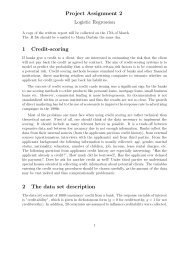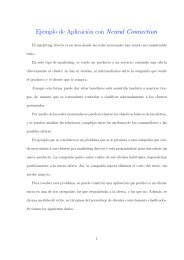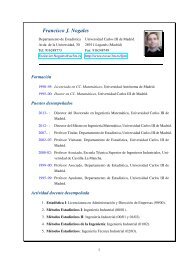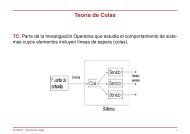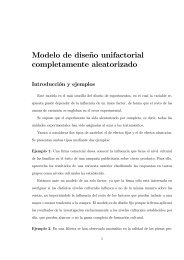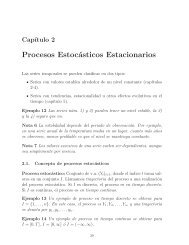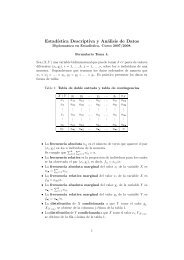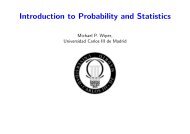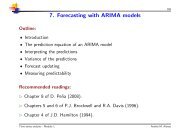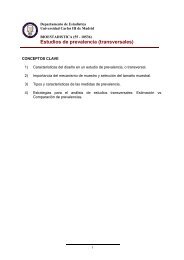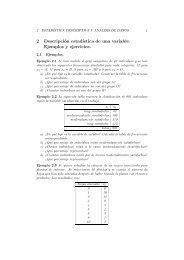Slides Chapter 1. Measure Theory and Probability
Slides Chapter 1. Measure Theory and Probability
Slides Chapter 1. Measure Theory and Probability
You also want an ePaper? Increase the reach of your titles
YUMPU automatically turns print PDFs into web optimized ePapers that Google loves.
<strong>1.</strong>8. RANDOM VARIABLES<br />
We will also use the notation p(X = x) = p X (x).<br />
The probability function induced by a discrete r.v. X, P X , is<br />
completely determined by the distribution function F X or by the<br />
mass function p X . Thus, in the following, when we speak about<br />
the “distribution” of a discrete r.v. X, we could be referring either<br />
to the probability function induced by X, P X , the distribution<br />
function F X , or the mass function p X .<br />
Example <strong>1.</strong>21 The r.v. X 1 : “Weight of a r<strong>and</strong>omly selected<br />
Spanish woman aged within 20 <strong>and</strong> 40”, defined in Example <strong>1.</strong>17<br />
(c), is continuous.<br />
Definition <strong>1.</strong>46 The probability density function (p.d.f.) of X<br />
is a function f X : IR → IR defined as<br />
{ 0 if x ∈ S;<br />
f X (x) =<br />
F X ′ (x) if x /∈ S.<br />
It is named probability density function of x because it gives the<br />
density of probability of an infinitesimal interval centered in x.<br />
The same as in the discrete case, the probabilities of a continuous<br />
r.v. X are determined either by P X , F X or the p.d.f. f X .<br />
Again, the “distribution” of a r.v., could be referring to any of<br />
these functions.<br />
R<strong>and</strong>omvariables, asmeasurable functions, inheritallthepropertiesofmeasurablefunctions.<br />
Furthermore, wewillbeabletocalculate<br />
Lebesgue integrals of measurable functions of r.v.’s using as<br />
measure their induced probability functions. This will be possible<br />
due to the following theorem.<br />
Theorem <strong>1.</strong>16 (Theorem of change of integrationspace)<br />
Let X be a r.v. from (Ω,A,P) in (IR,B) an g another r.v. from<br />
ISABEL MOLINA 41



